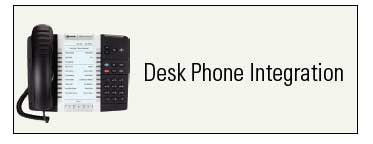The new Radio Branch Exchange™ (RBX) features the ability to expand the reach of unified communications applications to land mobile radio, allowing for a consistent experience for all workers in the field, at home or in the office. The RBX is based on open standards, which allows for flexibility when installed as an add-on to an existing IP PBX network or can be robust enough to meet the demands of a next-generation digital workflow intensive operation.
The RBX provides an organization with a healthy alternative to cellular solutions for their mobile work force. While staying connected in any location is paramount, the RBX delivers the same cellular functionality directly to the mobile worker's radio.
Key Benefits
- Expand Unified Communications coverage to two-way radio
- Elimination of cellular overhead
- Increase workflow & business processes
- Connect geographically dispersed radio users through central network
- Lower operational expenses by cutting out unnecessary communications devices
The RBX comes with an expansive feature set that gives an organization the flexibility to fully utilize the capabilities of a totally unified communications network.
Key Features
Mobile Extension for Two-Way Radio
Voice Features:
- Radio-to-phone / phone-to-radio or extension dialing
- Call twinning, forking, hunt groups
- Calling line ID
- Speed dialing
- Shared voice mail box
- Call timer
- Volume adjustment
Data Features:
- Voice mail notification
- Programmable alerts & alarms
- Missed call alert
- SMS & IMS
- DTMF tone generation
- Integrated directory with contacts import capability
- Backlit display
- GPS positioning
- Telemetry
Voice Interoperability
The RBX converts live voice traffic to SIP and delivers it to any device connected to an IP network, or better yet, anywhere in the world.
Value-Added Applications
Presence monitoring and GPS applications provide intelligent voice and data message routing to ensure that information is delivered to the hands of your most capable workers.
Scalability
The core of the RBX is designed to meet the requirements of business and government, large or small. Connecting as few as five radio users to virtually hundreds with simultaneous voice and data messaging gives the RBX the flexibility needed to deliver true value to your organization.
Unified Messaging
Configuration of the RBX lets users share voicemail boxes, notification settings, alarms, and more by delivering it right to the portable radio via the RBX radio unit user interface.
Radio Branch Exchange™ FAQ
What is the Radio Branch Exchange™ ?
The Radio Branch Exchange™ (RBX) is an enterprise level solution for organizations that are looking to bring a new layer of connectivity to their existing unified communications platform. The RBX is designed to receive, manage, and deliver voice and data messaging from IP PBX backbones and two-way radio networks. The RBX is an autonomous system and consists of a server and hardware component, each of which can be treated as an add-on to an existing IP PBX and radio platform or can be built into a multi-vender environment.
What two-way radios are currently compatible with the Radio Branch Exchange™ ?
The Radio Branch Exchange™ is currently compatible with Motorola MOTOTRBO digital two-way radios. In order to utilize the full feature set of the RBX, users must have a MOTOTRBO network. In the upcoming months, look for this list to expand.
Does the Radio Branch Exchange™ require me to replace my existing radio network?
Although the Radio Branch Exchange™ is only compatible with MOTOTRBO radio units to date, this does not mean that you have to replace all of your existing radio equipment to experience the benefits of the system. The Motorola MOTOTRBO radio units are Analog/Digital units and therefore backwards compatible. An organization has the option to slowly migrate only a few users at a time to the MOTOTRBO radio line while still maintaining operational consistency.
This situation is ideal for installations where customers would like to try both the RBX solution and the MOTOTRBO radio line.
This also gives an organization the flexibility to connect selected radio users who would benefit the most the RBX, without having to allocate a large budget to rip-and-replace an existing radio network.
How many radio users can I have connected to the Radio Branch Exchange™ ?
The Radio Branch Exchange™ is designed to connect as few as five radio users or can be scaled to accommodate virtually hundreds of interconnected telephony and radio users globally under the one IP communications network.
How does the Radio Branch Exchange™ interface with an IP communications platform?
Built on open standards, the Radio Branch Exchange™ interfaces with an IP PBX platform through SIP trunks. The number of SIP trunks is dependent on how many concurrent messages are being delivered daily.
How do radio users use the Radio Branch Exchange™ ?
The Radio Branch Exchange™ has a user interface built into the radio, which allows for ease of navigation and provides the user with a list of features you would find common on standard cell phones. Through this interface, the user has access to the RBX features and menus.
How does the Radio Branch Exchange™ differ from cellular push-to-talk solutions (i.e. iDEN, Mike systems, etc.)?
The Radio Branch Exchange™ offers the same basic features you find on standard cellular push-to-talk (PTT) solutions. However, the RBX operates in self-managed RF networks and is directly connected into an organization's IP network. Because of this, the RBX is able to provide a level of value and benefit that cellular PTT solutions cannot guarantee.
Cellular PTT solutions are connected via cellular networks. While this is beneficial in certain circumstances, the users of the system are dependent on the cellular network coverage to remain connected. Operations in areas that have inconsistent or no cellular coverage cannot rely on constant connectivity and thus make these solutions less than desirable.
Cellular PTT solutions are expensive (reoccurring monthly fees). For some smaller operations, this may not be a huge concern. However, with larger installations, these monthly fees become taxing on operational expense budgets.








